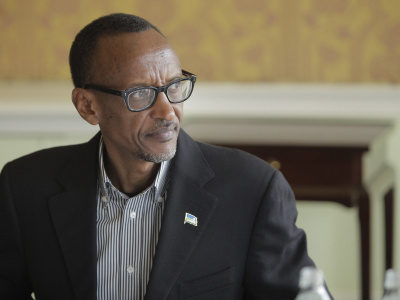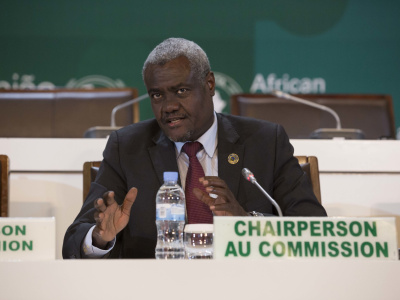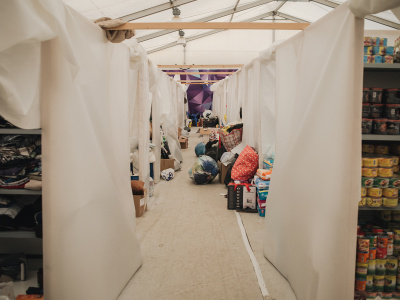
The race to close the gateway to Europe
As irregular migration to European countries continues, both the EU and its Member States have stepped up their efforts to reach a solution through the transit points in North Africa.
Since the beginning of 2017, nearly 100,000 migrants have arrived in Italy by boat while another 2,410 have died whilst making the treacherous journey. Most of these arrivals, the majority coming from Sub-Saharan countries, depart from the key transit point in North Africa, Libya. As such, Libya remains under the spotlight. Proposals on addressing the crisis in the central Mediterranean have multiplied since March 2016, when the EU succeeded in sealing a deal with Turkey to curb the flows through the Eastern Mediterranean. The EU has strived to reach agreements with source countries, but with limited success. It then found itself compelled to turn to transit countries in North Africa as a last resort to counter the challenge.
Libya, the gateway to Europe
In late 2016, some European officials proposed to intercept migrants at sea and place them in refugee camps in Tunisia or Egypt where they can apply for asylum before entering the EU. Some even suggested imposing trade sanctions for countries not willing to cooperate with the EU on this issue. These proposals, while not endorsed at the EU level, were rejected by the concerned countries, who argued that they were not main exporters of migrants and that they were already respecting agreements on border management with the EU. A range of initiatives have ensued to find a solution through Libya, a country torn by internal conflict since mid-2014. During the Malta Summit held in February 2017, European leaders adopted the joint communication addressing migration in the Mediterranean. The plan seeks to develop the capacities of the Libyan coast guard, disrupt the smugglers’ business model, and support the UN-recognised Government of National Accord (GNA) in managing its southern borders. The plan also stipulates increased coordination with Libyan local authorities, international organisations, and Libya’s neighbours.
According to the Malta declaration, EU leaders would continue to support Member States’ initiatives seeking to engage with Libya. They thus welcomed the Memorandum of Understanding signed between Italy and Libya in February 2017, according to which Italy would provide the GNA with money, training and equipment to support border management and enhance the capacities of the Libyan coast guard. In a follow-up to the Malta Summit, the EU Trust Fund for Africa adopted a Ä90 million programme on protection of migrants and improved migration management in Libya. According to figures released by the European Commission, the International Organization for Migration has facilitated the voluntary return of 7,084 migrants between January and September 2017, in comparison to 2,775 in all of 2016. President Tusk announced that the EU has so far succeeded in “the training of Libyan Navy Coastguards, the arrests of more than 100 smugglers and the neutralisation of more than 400 of their vessels”. Yet, commitment to this work plan seems to differ among Member States. In the European Council Meeting of last June, President Tusk noted that some Member States are not honouring their financial commitments and that they need to do more.
Italy’s migration policy shift
Italy has repeatedly asked for EU support as it found itself turning into a hotspot for migrants. Increased border controls by Austria and France resulted in migrants settling in Italy. Feeling left alone by other European countries, Italy stepped up its cooperation with the GNA. In early July 2017, the EU Commission adopted an action plan to support Italian efforts. A few months later, Italy‘s policy shift started to bear results, while in August 2016, 21,294 arrivals were registered in Italy, this number decreased to 3,914 in August 2017. Until very recently, Europe-bound migrants used to be rescued by European ships; now however they are mostly stopped in Libya. This new policy is predicated on several elements, including sealing deals with armed groups who control smuggling hotspots along the Libyan north-west coast, to halt the boats from leaving towards Europe; sending Italian ships into Libyan waters and assisting Libya in establishing its own search and rescue zone; a new NGO code of conduct limiting search and rescue operations; negotiations with tribes in southern Libya to control the borders; and increased discussions with Chad and Niger on migration. While Italy denies reaching agreements with smugglers, many reports note that the Italian government is paying militias usually involved in smuggling to assume the role of pushback. The Italian government reportedly negotiates these agreements and makes payments to these groups through interlocutors such as leaders of local communities.
Italy’s plan to deploy a mission of navy ships in Libyan territorial waters, along with the possibility of using planes, drones, and helicopters, triggered heated discussions within Libya. While Italy stressed that sending its military mission was upon a request from the GNA, Fayez al-Sarraj, Head of the GNA, initially denied submitting such a request, insisting that his government only asked for training and arms. Politically, Sarraj’s rapprochement with Italy did not please his rival in eastern Libya, General Khalifa Haftar, supported by the French, who even threatened to target Italian ships docking in Libyan ports. The proponents of Italy’s move argue that migration is a shared concern between both countries and that a solution is needed to protect Libya’s borders.
France steps in
In late July, France decided to take the initiative and invite the two rivals Sarraj and Haftar for a meeting in Paris, under the auspices of the UN – and without informing Italy. The meeting held on 25 July 2017 resulted in a joint declaration, including an agreement on ceasefire and elections for early 2018. After the meeting, the French President Macron stated that he wanted to establish hotspots in Libya where the migrants’ asylum applications can be processed. That same day, Macron said that hotspots are not actually being considered and that instead, France will help to create missions of the Office for the Protection of Refugees and Stateless Persons on ‘African soil, in safe countries‘, without specifying any timeframe. The French initiative, deemed as a “diplomatic success”, was not very welcomed by Italy, who perceived that France should not repeat past mistakes in Libya. The day after the meeting in Paris, Sarraj met with the Italian Premier Paolo Gentiloni in Rome, in a move that emphasises the GNA’s need for Italy’s support. Sarraj’s move could also have been motivated by concerns about the French support for Haftar, the self-proclaimed leader who has enjoyed French’s endorsement in recent years.
Light at the end of the tunnel?
While Italy has promoted its recent efforts as a contribution to “Libya’s path towards stabilisation”, some perceive that its approach could lead to maintaining or exacerbating instability, as it increases the leverage of militias and could potentially result in conflicts between armed groups over controlling the flows. The GNA, while endorsed by the UN, is not a strong partner and the armed militias are not reliable. Besides the focus on reducing migration through the Mediterranean, discussions in Europe are also shifting towards how to deal with the thousands of migrants trapped in Libya. Establishing or improving reception conditions for migrants in Libya in cooperation with international organisations has been repeatedly suggested. It is not clear however, if involving the militias in managing Libya’s detention centers is a realistic plan. At the same time, the current decrease in arrivals in Europe could offer a window for discussing more long-term alternatives that could be in the interest of both Europe and Africa.
Towards a mutually beneficial cooperation on migration
Migration currently dominates EU-Africa relations and it ranks high on the agenda for the upcoming Summit. The challenges to a mutually beneficial partnership on migration are numerous. Despite the existence of various frameworks for dialogue on migration between both continents, divergent narratives still impede a fruitful cooperation. While the EU is generally perceived as prioritising return and readmission, African states view migration as an opportunity and emphasize inter-African facilitation of labour mobility and the creation of more paths for legal migration. This runs counter to the European emphasis on border management and readmission. There are concerns that funding under the EU Emergency Trust Fund for Africa (EUTF), designed to address root causes of irregular migration, is being directed towards security issues rather than development.
The push for border management within the continent can ultimately threaten intra-African mobility. Because migration is such a polarising issue in the EU, it has become increasingly difficult to discuss long-term demographic shifts in Europe and legal migration from Africa. This poses the challenge of reconciling short-term with long-term objectives and using different tools for managing migration. Difficult security and economic conditions in the African continent are likely to persist. Current migration trends will continue, especially with such a large youth population. This requires African countries to invest seriously in their human capital. The AU’s Migration Policy Framework for Africa adopted in 2006, identifies priorities and provides recommendations for Member States and the Regional Economic Communities (RECs) on different migration issues. While this framework promotes the free movement of people within Africa and the protection of rights of refugees and migrants, it lacks the necessary mechanisms to monitor, enforce and guide Member States in developing their own migration policies. What could be needed by the AU and the EU is an intensified dialogue on the migration, development and regional integration nexus that can potentially reconcile conflicting agendas. Migration will continue to be a critical dimension of EU-Africa relations for a long time, but this focus on migration should not override other issues of critical importance.
About the author
Tasnim Abderrahim is a Junior Programme Officer at ECDPM.
Read the full magazine issue







